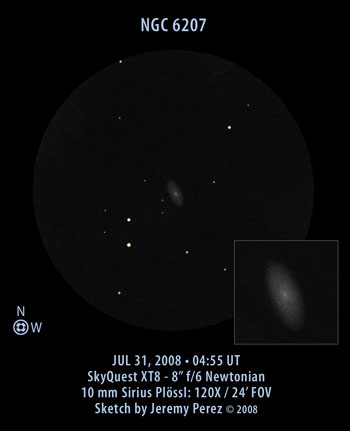Observation Notes:
I had never taken the time to look for this galaxy next to M13, but it was visible without much effort through the 8-inch Dob. It shared the view with it’s huge globular cluster neighbor at low power. The 120X view offered the best view, showing the galaxy to be elongated north-northeast to south-southwest at a PA of about 20 degrees (the NGCIC project lists a PA of 15 degrees). It appeared to be about 2 arc minutes long by 1 arc minute wide and sported a what appeared to be a nearly stellar core. This ‘core’ is apparently a superimposed foreground star. To the southeast, a pair of bright stars lit the view, with the brighter southeast star burning yellow-orange.
Object Information:
NGC 6207 was discovered by Friedrich Wilhelm Herschel in 1787. It is also cataloged as: UGC 10521, MCG+06-37-007, H II-701, h 1969, GC 4231, CGCG 197.007, KUG 1641+369, PGC 58827, IRAS 16412+3655, KARA 766
| Subject | NGC 6207 |
| Classification* | Galaxy (S II) |
| Position* | Hercules [RA: 16:43:03.9 / Dec: +36:49:56] |
| Size* | 3.0′ x 1.3′ |
| Brightness* | 11.7 vMag |
| Date/Time | July 30, 2008 – 09:55 PM MST (July 31, 2008 – 4:55 UT) |
| Observing Loc. | Flagstaff, Arizona, USA – Home |
| Instrument | Orion SkyQuest XT8 (203 mm dia./1200 mm F/L) |
| Eyepieces/Mag. | 10 mm Sirius Plössl (120X) |
| Conditions | Clear, calm |
| Seeing | 6/10 Pickering |
| Transparency | ~ Mag 6.0 NELM |
| *References | NGCIC.org |

This one shows up quite nicely with a larger aperture and dark sky. Pretty little galaxy near M13.
I didn’t know about the star at the center. Looked up a few photos and the star is directly beside the core, looks like what we see visually is a combination of the two. From comparing the red and blue DSS it looks like the star is heavy in the red/IR, so unfiltered CCD images will show the star as brighter than our eye sees.
It’s funny how simple it was to spot once I actually looked for it. It will be a regular stop anytime I check out M13 now.
While making the observation, I took for granted that I was simply seeing the core of the galaxy. Then I noticed Steve Gottlieb’s observing comments at NGCIC.org where he suggested it was likely to be a superimposed star. And sure enough, photographs and other reports made that appear to be the case. That’s an interesting note about the reddened spectrum. I wonder how much the star contributes visually to the combined glow of the knot at the center?
Thanks for the comment.
Jeremy